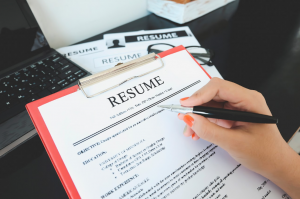In today’s competitive job landscape, creating a distinctive resume has become essential for securing your dream position. Gone are the days of using a generic, one-size-fits-all approach. Customizing your resume to align with each specific job application is now a vital strategy to grab the attention of hiring managers. This targeted effort showcases the strong alignment between your skills and the job requirements, increasing your chances of success.
Read on as this comprehensive guide provides essential tips and tricks for customizing your resume to match specific job postings, ensuring you present yourself as the ideal candidate.

1. Utilize Available Resources
Initiating the process of resume customization can be streamlined by using available resources and tools like an online CV maker. These digital platforms are equipped with various templates and aesthetic options, enabling users to craft resumes that are professional in appearance and engaging to the viewer.
The real advantage lies in the ability to easily adjust different segments of the resume, catering to the specific demands of varied job applications. This feature conserves valuable time and enhances the personal touch in each resume, making it uniquely suited to the job it’s intended for.
2.Analyze The Job Description Thoroughly
Diving deep into the job description is a critical initial step for tailoring your resume effectively. This requires a detailed analysis to unearth the essential skills, experiences, and qualifications the employer values most. Key phrases and recurring themes within the job description can also indicate what the company prioritizes and its underlying culture.
By understanding these nuances, you can better align your resume to meet the employer’s expectations, ensuring your applications resonate more strongly with the hiring manager’s requirements and the company’s ethos.
3.Highlight Relevant Experience
After gleaning insights from the job description, the next step is to filter through your professional history to spotlight experiences most relevant to the position. This selective process involves identifying roles and achievements that directly correspond to the job’s requirements. For example, if you’re applying for a customer service role, you would want to emphasize any previous experience you have in customer support or handling customer inquiries.
By strategically positioning these experiences prominently on your resume, you can significantly enhance their visibility to hiring managers. Consider using bullet points to summarize these roles and accomplishments to clearly communicate how your background makes you a fitting candidate for the job.

4.Use Keywords Wisely
Integrating keywords from the job posting into your resume is a strategic move in the era of digital recruitment, where technological innovations like Applicant Tracking Systems (ATS) are commonplace. Such systems scan resumes for specific keywords related to the job, making it imperative to mirror the language and technical terms used in the job description. This alignment can help increase your resume’s chances of passing through initial screenings.
However, it’s important to maintain a natural flow of language to ensure readability and coherence. As much as possible, avoid keyword stuffing, which can render the content awkward and unengaging.
5.Customize Your Professional Summary
The professional summary acts as a prime real estate on your resume, providing a snapshot of your capabilities and setting the tone for the rest of the document. That said, craft a summary that showcases your relevant skills and strengths and aligns with the employer’s specific needs, presenting yourself as the ideal candidate to address their challenges and contribute to their goals.
By tailoring this section to echo the core requirements and values highlighted in the job description, you can significantly impact your application’s effectiveness.
6.Showcase Transferable Skills
When direct experience in a specific field may be lacking, emphasizing your transferable skills becomes crucial. This is especially true since skills such as effective communication, leadership, and problem-solving are applicable and valuable across various industries and positions.
For example, if you are applying for a project management position but do not have sufficient experience in that role, highlight your organizational skills, ability to prioritize tasks, and track record of successfully completing projects on time. By illustrating how these abilities are relevant to the job, you can bridge the gap in experience and showcase your potential to excel in the new role.
Furthermore, highlighting these skills can demonstrate your adaptability and readiness to tackle the position’s challenges, making you a compelling candidate despite a non-traditional background.
7.Quantify Achievements
Quantifying your professional achievements adds a layer of credibility and impact to your resume, allowing hiring managers to visualize your potential contributions to their organization. You can offer tangible evidence of your capabilities by providing specific figures and statistics. For instance, you can mention that you led a highly successful email marketing campaign, which led to a 30% increase in online sales and a significant 20% growth in customer acquisition within three months.
This approach lends weight to your claims of past successes and gives employers a measurable gauge of the value you could bring to their team.
8.Pay Attention To Design And Layout
The aesthetic appeal of your resume, through its design and layout, can significantly impact the first impression it makes. Opt for a sleek, professional format that enhances readability, ensuring that key information stands out without overwhelming the reader. Ample white space and a clear, legible font are also essential to maintaining a clean appearance, facilitating a quick scan by hiring managers and making your resume visually appealing digitally and in print.
9.Highlight Education And Certifications
Emphasize your educational achievements and certifications, especially if they’re directly linked to the job requirements. This is crucial when the role demands specific qualifications or specialized training. However, even non-degree courses or certifications pertinent to the job should be prominently displayed. This showcases your commitment to your professional development and aligns your qualifications with the employer’s expectations, making your application more compelling.
10.Tailor Your Language And Tone
Adjusting your resume’s language and tone to reflect the prospective employer’s culture and ethos can also enhance your application’s resonance. For example, a more informal and innovative style may be appropriate for creative roles in dynamic startups. Meanwhile, positions in established professional firms might necessitate a more formal and conventional approach. This customization demonstrates your adaptability and understanding of the company’s environment, suggesting a natural fit within their team.
11.Include A Custom Cover Letter
Complementing your resume with a tailored cover letter provides an opportunity to deepen the narrative of your professional journey. This personalized document should articulate your enthusiasm for the role and elucidate how your unique blend of skills and experiences positions you as the ideal candidate.
It’s an avenue to express aspects of your professional persona that the resume format might not accommodate, such as your passion for the industry and your vision for contributing to the company’s future.
12.Proofread And Get Feedback
The final step in refining your resume and cover letter involves rigorous proofreading to eliminate any errors that could undermine your professionalism. Beyond a thorough self-review, soliciting feedback from mentors, peers, or industry professionals can offer valuable perspectives and insights, highlighting areas for enhancement you might have overlooked. This collaborative review process ensures your application is polished, coherent, and poised to make a strong impact.
Conclusion
Customizing your resume for each job application might seem time-consuming, but it’s a crucial step in the job search process. Demonstrating your unique fit for each role can significantly increase your chances of landing job interviews and, ultimately, your ideal job. Remember, a tailored resume shows employers that you want this job, making you stand out in a sea of generic applications.

